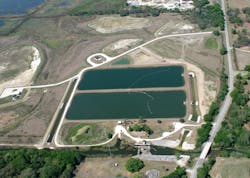Storm Water Monitoring for Nutrient Removal
The green, murky water in the lakes fed by the Apopka-Beauclair Canal in central Florida is caused by an overabundance of algae-feeding compounds—mainly phosphorus—resulting in chronic algal bloom. Ongoing efforts to bind phosphorus from surrounding former muck farms have significantly reduced the discharge of algae nutrients from Lake Apopka via the canal into the rest of the Harris Chain of Lakes. This would allow the other four lakes to have clearer water once again, enabling vegetation growth for improved fish habitat and less suspended sediment.
The Nutrient Reduction Facility (NuRF) project is centered on designing a system to inject aluminum sulfate into the nutrient-laden water in direct proportion to storm water volume. The facility, located adjacent to the Apopka-Beauclair Canal, would retain all of the phosphorous and aluminum sulfate products at its offline location, sending only clean water back into the canal and on to the other lakes. Incorrectly proportioned aluminum sulfate injection can increase costs while reducing efficiency. Crucial to this system, therefore, is the accurate and constant monitoring of flow volume in the canal during storm events.
The St. Johns River Water Management District contracted with the engineering firm Environmental Research & Design, and Technical Solutions (TSI) was selected to design the instrumentation, pumps and controls for the project.
The Challenge
Storm water in the Florida canal system is the most difficult fluid to measure, as it is typically slow moving, high in volume and contains all manner of contaminants, from tree limbs to shopping carts. The storm water flowmeter is one of the key components of the system; unless it operates dependably and accurately at all times (in the case of the NuRF project, flows range from below 5 cu ft per second to a maximum of 300 cu ft per second), the rest of the phosphorus nutrient removal system is rendered useless.
Initially, TSI selected transit time ultrasonic measurement technology; however, the main drawbacks of this method of measurement were limited flow accuracy and difficulty in servicing the sensors, because there usually is no cost-effective or easy way to dewater the pipe or culvert for transit time sensor maintenance.
TSI eventually chose the Teledyne Isco ADFM Pro20 Velocity Profiler, which not only measures flow accurately in difficult hydraulic conditions, but also is adaptable to a wide variety of installation configurations. TSI designed a stainless steel removable sensor holder made especially for this particular site. While the Pro20 flowmeter does all that the transit time system did, the mounting framework is easily removed by one person, allowing servicing of the sensor whenever necessary, with no need for dewatering.
NuRF Project Basics
Aluminum sulfate is injected into the nutrient-laden storm water as it enters the headworks just downstream of the Isco Pro20. Air is injected from a manifold mounted on the bottom of the channel to agitate the aluminum sulfate, mixing it with the inflow. Particles and contaminants begin to clump together into snowflake-like globules called “floc” as they flow downstream toward two settling ponds. As the storm water enters the ponds, the velocity decreases, allowing the heavier floc to sink to the bottom. In both ponds, dredges travel from one end to the other, vacuuming out the floc and pumping it to a storage tank for later dewatering by centrifuge. The clean water then continues its journey through the effluent gates and into the ditch, which returns the water to the canal downstream.
How It Works
The ADFM Pro20 system, which accurately measures flow rate in depths up to 18 ft, is especially suited for measurement in large pipes and channels. Four independent pulsed acoustic beams pointing in different directions in the flow measure velocity at multiple levels (bins), creating a true velocity profile of the channel. An ultrasonic level sensing ceramic points straight up and measures liquid level. Advanced algorithms automatically adapt to changing hydraulic conditions. This technology eliminates the need for on-site calibration and ensures accurate flow rate measurement even in difficult flow conditions with turbulence, non-uniform flow, backwater, high velocity, near-zero or zero velocity, and reverse flow.
The ADFM Pro20 was installed at the NuRF facility headworks, where it transmits flow data to the Central Controller Building, which houses the aluminum sulfate supply and pumping system. The controller then regulates the volume of aluminum sulfate injected into the influent water with proportion to the measured flow.
Success
Lake County Water Authority’s Water Resource Program Manager Ron Hart said of the facility, “Since it began in 2009, the NuRF has removed [more than] 3 tons of total phosphorus from the downstream load. The results are evident in the water quality improvements to the receiving lakes.”
The success of the NuRF project is the result of the collaboration and teamwork of a diverse group of entities, from engineering and designing to manufacturing and technologies.
Shoshana Sumrall Frerking is a technical writer with Teledyne Isco. Sumrall Frerking can be reached at [email protected] or 402.465.3914.
Download: Here


